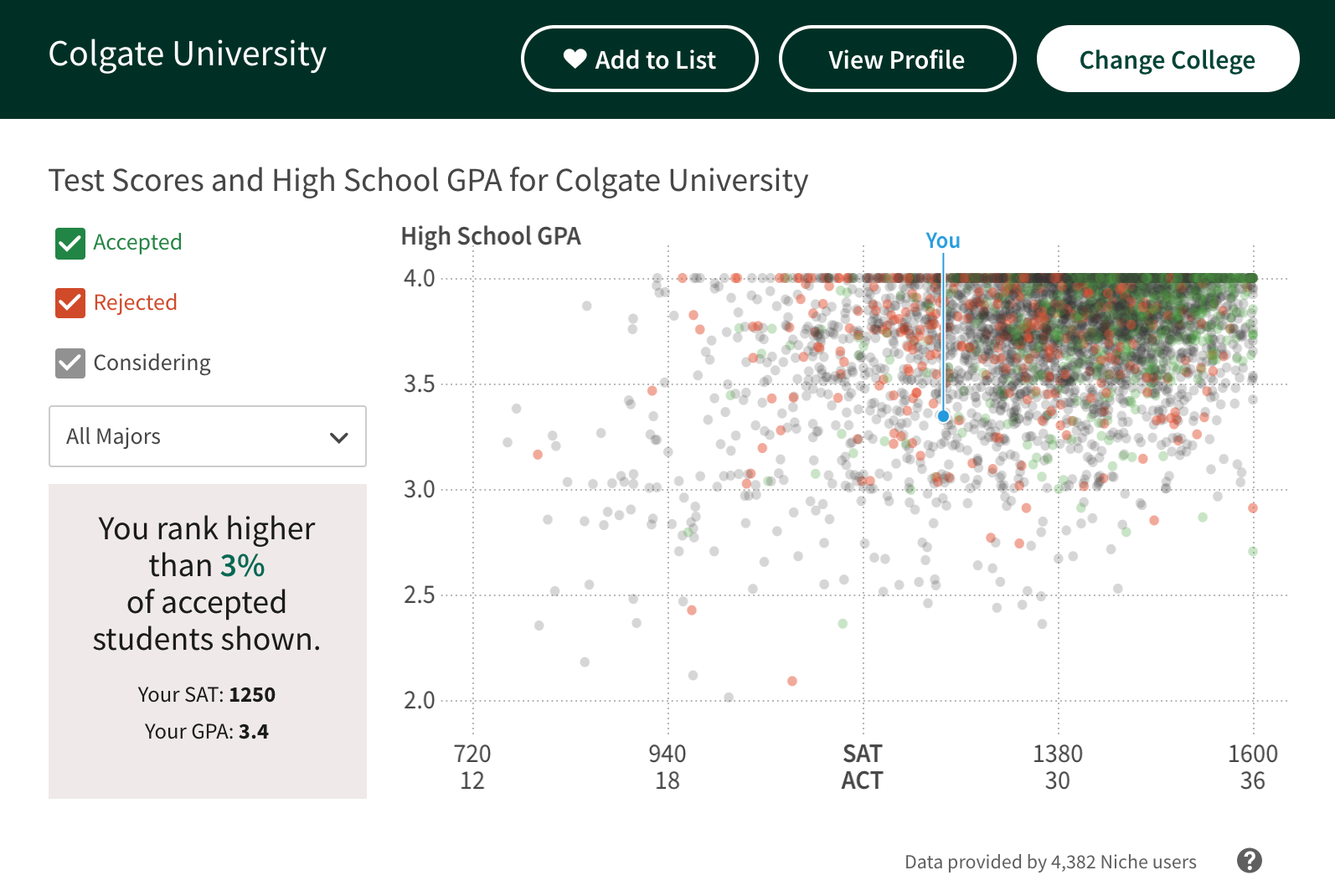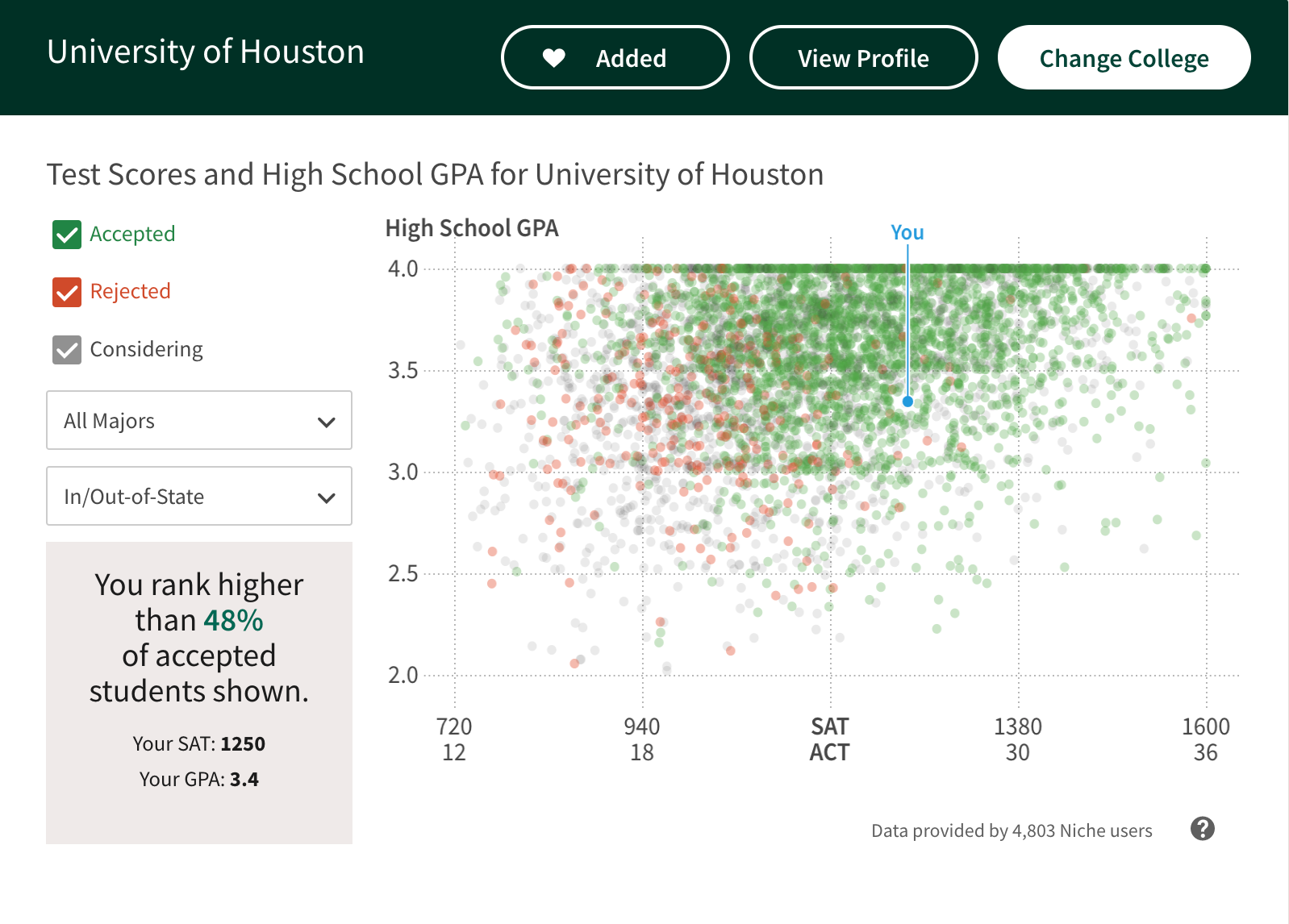Reach, Target and Safety Schools. How Do I Know What Works for Me?
Learn about different Reach, Target and Safety Schools
Bullseye! Take aim at your target schools
Find out if you are a competitive applicant with CollegeSimply
What Are Reach Target and Safety Schools?
When creating a list of potential colleges to apply to, you should include schools that fall into three different categories: Reach, Target, and Safety schools. You may have a dream university that you aim to attend; however, there is a possibility that you might not be admitted into this school. Having target and safety schools that reflect your academic credentials (GPA, test scores, extracurricular activities, and class ranking) is important and will help you gain admissions to the universities you choose.
Applying to colleges is a difficult process to navigate and has unforeseen challenges that will present themselves, especially when developing a list of potential schools. Researching is the first step when deciding on your Reach, Target, and Safety schools. This process is needed to tailor a list of the best possible options for your future college. When researching, you should explore each university's website to find out the academic programs, the rate of diversity, affordability and the requirements needed for admissions. The smallest details that each college provides for admissions can be the difference between acceptance or rejection. This includes checking the GPA and test scores needed to achieve admissions. Grade point averages (GPA) is not always a perfect measure of your academic standing. High schools across the country calculate GPAs differently and this factor could impact your application results when applying to colleges.
Learning about the weighted and unweighted grade point system is necessary when applying to colleges. Typically high schools use an unweighted GPA, while colleges use weighted GPAs to determine how competitive applicants are. Many colleges will recalculate your GPA if it is unweighted, so be mindful and check the GPA ranges and types that each school is accepting. Having a weighted GPA will demonstrate to colleges that you have taken challenging courses and you are committed to advancing in your academic journey.
For more information on the college admissions process, the college admissions process, navigating college, and college counseling services check out our blog: https://www.socraticssummeracademy.com/blog.
Reach, Target and Safety Schools
After determining the schools that you are interested in, you can categorize them into three groups that determine the possibility of your admissions to any university that you want. Reach, Target, and Safety schools are terms used to identify the universities that you have a higher or lower chance of gaining admissions to. The categories for schools can be labeled as such (this is an estimate based on a student with average grades. Make sure to calculate this yourself based on your GPA and test scores):
Super reach: 0-15%
Reach: 20-35%
Target: 36-75%
Safety: 76-100%
Super Reach Schools
Super reach schools consist of prestigious universities with an acceptance rate of 15% and lower. These typically include Ivy League Institutions such as: Stanford, Harvard, Princeton, Cornell, Yale, Columbia, University of Pennsylvania, Dartmouth and Brown. There are a plethora of other super reach schools that you may not get into even with a competitive college application. These institutions have a long history of selective admissions for applicants and will choose potential students based on a strong application and/or the legacy system that favors students whose parents and grandparents previously attended these schools.
This is not to discourage you from applying. If you believe that you are a competitive applicant, who has worked extremely hard to attend the school of your dreams and have achieved academic credentials that are above the required stats being asked for, apply to at least 2 of these schools. Super reach schools are still worth applying to, even if you are not accepted. The important thing is the efforts you have made during your high school career and your dedication to furthering your education.
Reach Schools
Reach schools consist of institutions that have a low rate of admissions, but high academic ranges and requirements. These universities are difficult to gain admissions to, and typically have an acceptance rate between 20 and 35%. Examples of reach schools include: Skidmore College (acceptance rate of 30%), Wake Forest University (acceptance rate of 28%) and Boston University (acceptance rate of 20%).
These schools are highly competitive and admit students with exceptional applications. If you are seeking admissions to these schools, and your GPA or test scores are significantly below the academic range indicated by the school, there is a strong possibility that you will not receive admissions. For example: Leah is applying to Colgate University (acceptance rate of 23%) with a 3.35 GPA and an SAT score of 1250. Meanwhile, the average student applying to Colgate University has an SAT score between 1370–1500 and an average GPA of 3.77.
Colgate University is considered a reach school for Leah, because she does not have the scores compatible with the average range for Colgate applicants, and will not be competitive against other students with the average performance record and higher. This does not mean Leah should not apply to Colgate University. Although the odds may not be in her favor, the college admissions process is not determined solely by your GPA or test scores. Other factors involved in the college admissions process includes a strong personal statement, remarkable extracurriculars or a lasting impression on Admissions Officers, if an interview is required.
Aim High! These statistics are not to discourage you from applying to different Reach schools. The college admissions process can be unpredictable and you will only know the outcome if you apply. Nevertheless, if you know that you will not be accepted into your reach school, there is no need to worry. You will have other options, such as your Target or Safety schools to rely on to yield better results.
This scattergram from Niche depicts Leah’s GPA and test scores against scores from other applicants and her chances of getting into Colgate University. The scattergram shows where Leah is placed because of her stats and shows that she is not in the “accepted'“ cluster and is surrounded by rejected or considering applicants.
Be realistic! If you know that you are a competitive enough applicant, continue the college process by applying to schools where you meet the standards enforced by the institution. Always try your best and remember that there are other universities that will satisfy the services, facilities and academic programs you want in a college.
Target Schools
Target schools are schools that you are more likely to be admitted into and have an acceptance rate between 35 and 75%. If your standardized test scores and GPA meet the requirements and range scores these universities are looking for, then there is a greater likelihood that you will receive an admissions offer.
After exploring different reach schools, Leah now needs to find target schools that will accept students with application statistics close to a 3.35 GPA and 1250 SAT score.
According to the CollegeSimply website, Leah’s GPA and test scores indicate that she could gain admissions to:
Penn State University - acceptance rate of 76%, average SAT scores ranging from 1070-1310 and an average GPA of 3.59
University of Houston - acceptance rate of 65%, average SAT scores ranging from 1140-1310 and an average GPA of 3.54
University at Albany - acceptance rate of 54%, average SAT scores ranging from 1090-1250 and an average GPA of 3.5
Using CollegeSimply to find Reach, Target and Safety Schools
The CollegeSimply website is a resource that generates Reach, Target and Safety schools based on your academic records and test scores. With this information inputted into their system, CollegeSimply will provide possible matches and a percentage that shows your likelihood of gaining admissions. For example: the target schools that were suggested for Leah showed a percentage of her “admission chance.” With Penn State, Leah has a 73% chance of being accepted, and has a 61% chance of getting into the University of Houston and the University at Albany.
Using CollegeSimply will simplify the research process and show you different universities in each state, the best schools in which region and the best schools for a lower cost. In addition, CollegeSimply will provide you with a detailed analysis of potential Reach, Target and Safety schools and your chances of being accepted to universities across the country.
Safety Schools
Safety Schools are universities or colleges that have a higher rate of admissions, with an 80% or higher chance of being admitted. Safety schools, also known as “back-up schools,” can be the schools in your state and are the least expensive option. When choosing safety schools, look for schools with rolling admission; this will allow admissions officers to review your application when they are received and you are more likely to hear back from colleges sooner. There are no guarantees when applying to colleges; however you should be confident when applying to safety schools because your standardized test scores and grade point average will exceed the requirements needed for admissions.
It is recommended to apply to one or two safety schools. Although this is common advice for students applying to college, the amount of safety schools you apply to depends entirely on your academic and financial situation, and what you know is best for you.
Safety schools are necessary when making a decision on the schools that you will attend. For many students, having an affordable option is important and safety schools meet the criteria for these students. If cost is a big factor when choosing a school, and your financial aid offer is not the best from your reach or target schools, your safety schools should be used to determine a better and inexpensive option that is still desirable.
When considering safety schools, spend as much time finding the schools that you are interested in. Do not use this category as “throw away schools” or schools you have no intention of attending. Therefore, you should conduct heavy research on these schools because they will help you fulfill your goal of attending college.
What Should You Do if You Dislike Your Safety School options?
If you do not like the safety schools that are recommended for your GPA and standardized test scores, figure out why these schools are undesirable to you. Is it the location? Was the college size too big or too small? Do they offer the majors/minors you are interested in? If you are unsatisfied with the academic and extracurricular programs that the school provides, that is alright. The college process is about your colleges choices and the schools you find favorable.
If the safety schools in your state does not have the programs that you are considering, apply to more target schools or look for safety schools in another state. There are thousands of schools in the United States, so there are many options to choose from. You should focus on the schools that you want to get into, do more research and find better safety schools that suit your needs.
















